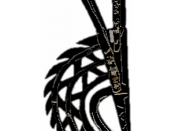For centuries, humans have attempted to explain the Sun in terms of their own worldviews. The Sun can be a god, a demon, a mischievous spirit, an omnipotent creator or a ruthless taker of life. Whatever role it plays, most cultures have recognized the significance of the Sun as prime controller of all life on Earth. These myths, legends and tales represent their culture's worldview, people's attempt to explain, understand, and come to grips with nature's phenomena. To the people who tell them, these stories are as relevant and true, as deeply meaningful and spiritually important, as any scientific explanations. The following paragraphs will discuss three of the many cultures that have worshipped the sun.
Re was known as the sun-god and the creator in ancient Egypt. He took on many forms, each depending on where he was. Usually Re was portrayed with a hawk head, wearing a fiery disk like the Sun on his head.
In the Underworld, the god took the form of a ram-head.
For the Celts, who lived in central Europe, Lugh was a Sun god. The underworld god Balor was his grandfather. Balor was the leader of the Fomorii. The Fomorii were evil people. According to a prophecy, Balor was to be killed by a grandson. To stop the prophecy from coming true, Balor tried to kill his grandson. Lugh miraculously survived. He was secretly raised by the god of the sea, Manannan, and became an expert warrior.
Balor had an evil eye capable of killing whoever looked at it. Lugh threw a small magic stone into Balor's eye and killed Balor.
Liza is a deity of the Fon people who live in West Africa. Liza is associated with the Sun, which is regarded by African people as fierce and harsh. Liza is...


